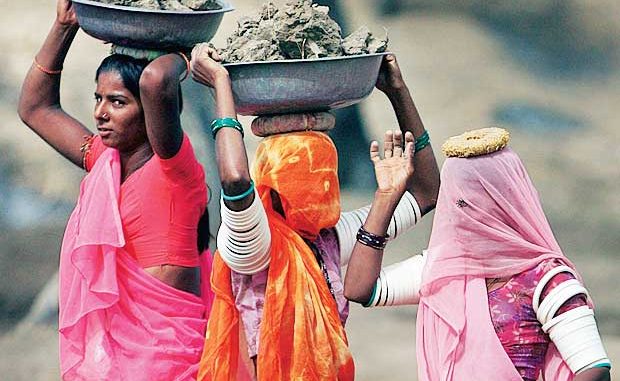Consistent De-Feminisation Moves Rural Economy Into Unorganised Abyss

The rural economy has seen a transition from being a strong agricultural workforce provider to a massively overburdened unorganised labour force. Unfair labour market practices with structural wage inequalities has pushed several small scale agricultural households taking up non-farm related activates.
Unfortunately, a massive effect of this is more often seen in the female labour force participation rates (FLFPR) among the rural households. There has been consistent reduction and withdrawal of women workforce known as de-feminisation from the rural economy. With more women taking up domestic unpaid work in the recent years, the effect to which can be categorically analysed in the depleting grain security status among the rural poor.
There is enough evidence and academic literature to prove that rural households which have financially non-participating women, have worst indicators of malnutrition and food security. Though the concept of grain poverty has multidimensional scopes, but non-participating women workforce is a critical factor that needs to be analysed in depth.
The distribution of wages between men and women workforce with context to the rural economy, comments on the growing gender gaps and disparity of male and female wage distribution. Several independent organisations have strongly advocated that the per capita income in India could achieve a 10 % increase only if the existing gender participation rates be balanced.
Data on critical and marginal households in rural India depict that, significant loss in the bargaining and purchasing power among the rural women have hit the grain procurement rates at the household level. In most of the government allocated fair price shops, the average purchase of subsidized grains is done by the women workforce who tend to be cheated on the basis of lack of negotiating power.
In case of failure to procure grains from the PDS shops the households run by non-participating women workforce face severe marginalisation due to inability of direct purchase of non-subsidized food grains from the market. If we collect data on the average per capita grain expenditure of vulnerable household exclusive of PDS purchase, we would definitely see a trend on the fall in average procurement rates by women.
We know that the women workforce suffers from occupational segregation where most of the work is chosen or related to geographical and demographic indicators, but consistent defeminisation has a larger framework to it. There can be two main hypotheses to it-1) either most women are withdrawing from the labour market due to lack of credibility, inconsistent education and are poorly skilled 2) or most of the work is being allocated to the male workforce.
If we observe the wage trends in rural India it is seen that in the last ten years of development the share of women workforce has reduced from 40.7 % to 20.2 % while there has been significant increase in the male labour force. The most popular U-hypothesis in the feminism debate believes that as the economy moves into a developing stage the women workforce tend to withdraw themselves from the labour market but after reaching a minimum threshold it starts increasing again.
Such an argument does not stand much relevance in the missing women labour figures in context to rural India where trade elasticity of the market did not engage in increased women participation after the liberalisation period. This also means that there is no significant relationship between trade openness and women labour participation in rural India. It is thus rightly to believe that in a patriarchal led labour system the women workforce significantly undergoes female marginalisation.
About 75 % of the women workforce majorly associated with the agricultural sector faced de-feminisation during transition to wage termed capitalist based agriculture practices that led to reversal in women participation rates. During this transition period while the male workforce had a steady transition into non-crop agricultural practices, the women workforce faced a ten percent decline with majority of them challenged by severe income effect.
One major effect of the prolonged agrarian crisis in India was reduction of average land holding among the rural households. The share of non-cultivable agricultural lands increased dramatically up to 64.1 % during the agrarian crisis and most of these vulnerable households took to construction labour work for livelihood. In this period there was further de-feminisation due to stigmatisation in certain labour related activities that didn’t allow or encourage women participation.
The National Rural Employment Guarantee Act (NREGA) and other non- agricultural employment schemes are not devoid of such stigmatisation and rigid labour norms affecting female participation.
The government of India’s food safety net programmes have been persistently failing in achieving targeted outcomes for the marginal rural households. A major reason to this is also because of lack of financial abilities among the women nutritional givers and caretakers at the community level. With a majorly unequal wage distribution policy and severely falling participation rates chances of female workforce exclusion from the rural economy is certain.
It has been a growing tendency of the Indian economy to not count and analyse the reasons for the missing labour participation among the rural households. In context to the India labour market like it is necessary to eliminate all kind of gender related wage differentials and advocate a free and fair labour market practice. Seeing development as an equal process involving active participation from both the male and female workforce is a major outcome for a democratically driven economy like India.



